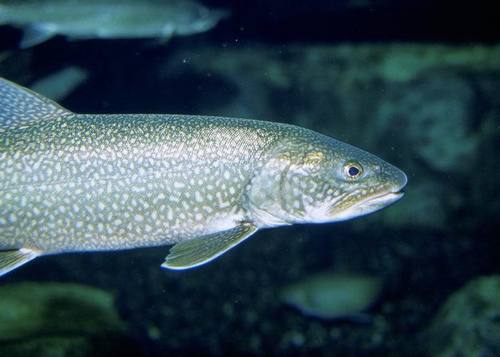
Lake Trout
The Atlantic bluefin tuna (Thunnus thynnus) is a majestic and highly migratory species, prized for its size, speed, and the quality of its meat. It plays a critical role in marine ecosystems and is a top predator.
20 70 years
Lifespan
63 cm
Length
Least Concern
Conservation Status
20 km/h
Swimming speed
Carnivorous
Diet
Local Migration
Migration
Appearance Overview
The Atlantic bluefin tuna is renowned for its large, streamlined body, built for speed and endurance in the water.
Color
Dark metallic blue above and silvery white below, providing camouflage from above and below.
Fins
Two dorsal fins; the first is depressible, yellow or bluish.
Body
Torpedo-shaped body, aiding in efficient swimming.
Length
Up to 13 feet (4 meters)
Weight
Up to 2,000 lbs (907 kg)
Diet
Carnivorous, feeding on a variety of fish, squid, crustaceans, and occasionally, even on kelp.
Feeding Behavior
Highly active predators, they use their speed to chase down prey and often feed in coordinated schools.
Social Behavior
Migratory, forming large schools, especially during spawning, but can also be found in smaller groups or solitary.
Commercial Relevance
Extremely high value, especially in sushi and sashimi markets, where its fatty meat is a delicacy.
Conservation measures
Stringent fishing quotas, international agreements, and marine protected areas are in place to manage stocks.
Status
Endangered
Threats
Overfishing is the primary threat, exacerbated by the high demand for sushi; climate change also affects migration patterns and prey availability.
Habitat Distribution
Depth Range
0-1,000 meters, though they are commonly found in shallower waters.
Geographic Range
Atlantic Ocean, Mediterranean Sea, and the Gulf of Mexico.
Preferred Environment
Temperate and subtropical waters; highly migratory, often crossing entire oceans.
Reproduction and Life Cycle
Breeding Habits
Spawns in the warm waters of the Mediterranean Sea and the Gulf of Mexico, with specific spawning grounds known for their consistent conditions.
Development Stages
Larvae hatch in plankton-rich waters, developing rapidly into juveniles. They grow quickly, reaching substantial sizes within their first few years.
Fecundity
Females are highly fecund, capable of producing up to 30 million eggs per spawning season.
Maturity Age
Typically reaches sexual maturity between 4-8 years, though this can vary depending on environmental conditions and population.
Faqs about Lake Trout
Where can you find Atlantic bluefin tuna?
Atlantic bluefin tuna are primarily found in the Atlantic Ocean, ranging from the cold waters of the North Atlantic to the warmer waters of the Gulf of Mexico and the Mediterranean Sea.
What do Atlantic bluefin tuna eat?
Their diet consists mainly of smaller fish, squid, and crustaceans. They are opportunistic feeders and can also eat kelp and other marine vegetation.
Do Atlantic bluefin tuna migrate?
Yes, due to their migratory nature, they can travel thousands of miles across the Atlantic Ocean.
How long do Atlantic bluefin tuna live?
They can live up to 40 years, although this is rare due to fishing pressures.
Why are Atlantic bluefin tuna so hard to catch?
Their speed, size, and the depth at which they swim make them challenging to catch, requiring specialized fishing gear and techniques.
Why is bluefin tuna so expensive?
The high demand for bluefin tuna in sushi markets drives up its price, making it one of the most expensive fish in the world.
Copyright @ Nature Style Limited. All Rights Reserved.
 English
English